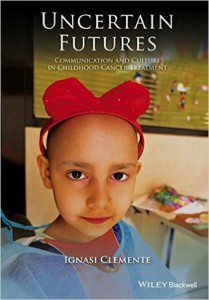Childhood Cancer: Powerful Words
review by Cindy Dell Clark, PhD.
 Uncertain Futures: Communication and Culture in Childhood Cancer Treatment
Uncertain Futures: Communication and Culture in Childhood Cancer Treatment
by Ignasi Clemente
Wiley-Blackwell, 248 pp, October 2015
With regard to our kids, words we hope never to hear or have to say include “cancer” and “death.” We hope to avoid these words altogether, and when they arise, there is a tendency to shower the children involved with charity, pretense, and diversion: visiting clowns, get-well toys, or, as a last resort, wishes-come-true through the Make-A-Wish Foundation or Kids Wish Network. Justin Bieber alone is said to have participated in some 250 wishes-come-true for children with life-threatening conditions.
In Uncertain Futures: Communication and Culture in Childhood Cancer Treatment, linguist Ignasi Clemente gets to know the experiences of children for whom the word “cancer” has become all too descriptive. (Nevertheless, even in the clinic this word is avoided.) Clemente asks what talk and evasion—among young patients, their parents, and their physicians—reveal about the experiences of children and the adults who care for them.
Clemente, a native speaker of Catalan and Spanish, is on the faculty at Hunter College in New York. Clemente’s ethnographic work was conducted in a Barcelona hospital, but his discussion brings to light many parallels with research done in the United States. Avoidance of discussing death openly with a dying child, for example, is a central theme of Myra Bluebond-Langner’s highly recommended classic ethnography The Private Worlds of Dying Children.
If the reader can look past the technical jargon (and in that regard the first chapter might well be skipped by those more interested in sick children than in the field of linguistics), this book has the potential to ignite dialogue about how physicians and parents talk about cancer with and around the children most directly affected. In an era of growing support for patient-centered treatment, it is intriguing that language itself—usually thought of as communicative—can also serve as a social tool through which those with more power (physicians) successfully evade the topics and inquiries posed by those with less power (youths).
A pattern echoes across the conversations analyzed: the ethos of the children’s hospital favors optimism and positive emotions and eschews directly pondering uncertainty or dread. Children, parents, and physicians all have a role in keeping negative insinuations out of their talk. When a young person asks a question that has the potential to bring to the fore negative or uncertain issues (“Will that drug give me mouth sores?”), doctors skillfully skirt the question (no doubt by habit) rather than directly answer. Physicians have a repertoire of avoidance strategies, including making lighthearted jokes or downplaying or reframing young patients’ questions. Those young people who persist in wanting answers use every skill of social conversation and medical information to obtain them. (In many cases, of course, factual answers “leak” indirectly, perhaps through other sources.) As an unspoken rule, parents and children scrupulously avoid questioning medical authority.
Parents and physicians alike have a moral basis for regarding treatment in positive terms, as having nurturing intent. Yet mothers, whose authority is less reified than that of physicians, become targets for resentment by their sick children. Patient-mother conflict seems to be a frequent outlet for a sick son or daughter to vent their discontent, frustration, and anxiety. Suffering for the pediatric patient entails loss, pain, and worry, whether or not this is speakable in clinical exchange. Loving mothers serve as safe targets for many young patients’ anger, adding significantly to maternal stress.
Clemente’s focus on spoken language paints a picture more relevant to teen patients than to very young children. Yet through its careful analyses of conversation, the book convincingly highlights how issues of patient power are ultimately local and in situ. Making health care more family- and patient-centered will not be achieved with top-down decrees alone. This may be especially true in pediatric health care, where adults have an implicit moral dictate to take an upside view of treatment initiatives, even if it means dismissing or marginalizing a young patient’s worries. Systems of power and meaning are not matters external to families and care providers. Shared meaning is dynamic, negotiated by involved parties themselves through social interplay. In this process, youths seeking answers about their own illness can be stifled rather than empowered.
A version of this article has previously appeared on http://childsworldamerica.org
